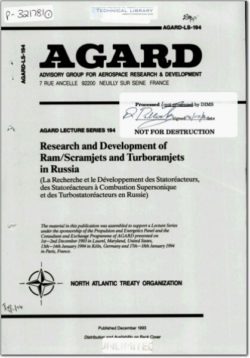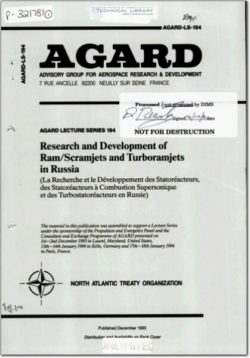AGARD-LS-194

- Version
- 240 Downloads
- 15.47 MB File Size
- 1 File Count
- April 26, 2016 Create Date
- April 26, 2016 Last Updated
Research and Development of RAM-Scramjets and Turboramjets in Russia

It is well know that the use of ram/scramjet
principle permit to broaden the sphere of
airbreathing engines application to the high and
hypersonic flight speeds area especially when
using HQ- fuel (Fig. 1.1).
Ram propulsion can be divided into three
groups which characterized by type of engine,
fuels and application (Fig. 1.2):
1. Ramjets or ramrockets for missiles which
equipped with power boosters. They use liquid
fuels (LFRJ) or solid propellants (SPRR). The
possible Mach number flight range extends from
l,5 - 2to 3 -4,5.
2. Combined engines (TRJ, ATR and
others) with ram duct. The gasturbine core engine
of them usually is switching off near the flight
Mach number of 3. The maximum flight Mach
number of ram duct work extends up to 4 - 4,5
by using of kerosene and up to 6 - 7 by using
cryogenic (LHz) fuel which has big cooling
capacity. Their application may be on hypersonic
cruise aircraft or on aerospace planes for the first
stage of their acceleration.
3. Supersonic combustion ramjets using
LH2 have the operating Mach number range
from 5 - 6 (dual mode sub/supersonic
combustion SCRJ: from 3 - 4) up to 10 ~ l5 and
more if the oxygen boosting is used. The
application of such engines may be realized on
hypersonic cruise or aerospace planes. Scramjets
can power hypersonic cruise missiles when using
heavy liquid fuels, for instance endothermic
hydrocarbon fuels. In such case the FV cooling
problems restrict the maximum value of flight
Mach number on 6 ~ 7 limit.
The first, group of ram propulsion is in
quite wide service or under development on
different missiles, but the second and the third
groups of engines are on different stages of
scientific study, research and development.
Unlike the aviation gasturbine engines the
use of ram propulsion connects with application
of different kinds of fuels: from common
kerosene to slush, solid propellants and cryogenic
fuels, such as LH2 and CH4. This problem must
be overviewed [l2].
Mendeleev Table of chemical elements
gives us only 7 elements with the mass heat of
combustion Hu > 25 MJ/kg (Fig. 1.3). Hydrogen,
beryllium and boron have the most mass heat of
combustion, and boron, beryllium, carbon and
metals: aluminium and magnesium — the most
volumetric heat of combustion.
| File | Action |
|---|---|
| AGARD-LS-194 Research and Development of RAM-Scramjets and Turboramjets in Russia.pdf | Download |
Comment On This Post